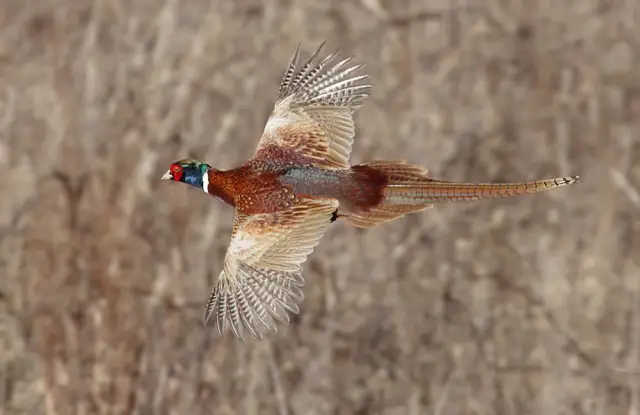


Picking a Pheasant Load

Selecting good pheasant load candidates isn't very difficult, providing you don't skip the critical step of patterning your shells at the ranges you want to be effective at. If you skip the patterning part, you might as well be shooting blind as you have no way to differentiate between shells-- they all look similar before they are fired. Nor can you tune your pattern to be the most effective, meaning the largest effective spread at the ranges you're working with.
If you shoot steel, the choice is #2 steel. This have been proven to be the best shot size for pheasants with steel, at all ranges, by Tom Roster's multiple year study. There is no question about it. Steel shotshell and choke combinations pattern wildly different, so only the pattern board with five shot pattern averages can show the more effective combinations for you.
With lead, Kent Tungsten-Matrix, or Nice Shot, there is little doubt that #5 shot is the best choice, the most effective at all ranges. When #5 falls off, past fifty yards, going to #4 will reduce your pellet count so much as to reduce your effective pattern size exactly when you don't want it-- at extended ranges. Though lots of things may work, that isn't the idea of hunting for sport at all. It isn't simply that it can work, or it has worked, it is what wounding ballistics have shown will yield 100% game recovery if we hit what we are shooting at. The problem with alleged “misses,” is that we will never know if that's what they are. With 500 pellets or more in a shot cloud, if we don't go pick him up we might as well be feeding the coyotes. No one can account for all 500 pellets at thirty yards, much less fifty years. If we think we can control a pellet, then we likely should be pheasant hunting with air rifles. We can't, though . . . that's why we use 500 pellet payloads.
Here is a comparison of 1-1/8 oz. #2 steel, 1-1/4 oz. #5 lead, and #5 1-1/8 oz. Kent Tungsten-Matrix or Nice Shot. 1-1/8 oz. steel indicates 12 gauge due to case capacity, but 1-1/4 oz. and 1-1/8 oz. lead and Kent TM loads are twenty gauge loads as well as sixteen gauge shotshells, the shotguns I've used most to take wild pheasants every year for over forty-five years by now.

You'll quickly note that even faster muzzle velocity steel looks pretty sad compared to lead or Tungsten-Matrix at 40 yards. Beyond that, it just gets worse. You'll get more penetration with lead and Kent TM, over 27% more at 40 yards, 37% more at 50 yards. At fifty yards, while Kent TM and Nice Shot give you nearly 1-3/4 inches of penetration (1.73 in.), #2 steel is down to less than an inch and a half (1.36 inches).
Also, note that with identical payload mass, 1-1/8 oz., Kent TM and Nice Shot loads can be substantially lower recoil loads as well, never a bad thing when taking that second bird quickly. A "Modified Choke" pattern percentage from lead or Kent TM is better than a 100% steel pattern, and due its larger effective spread, a better choice for pheasants without question.
Effective pattern size is far, far better with identical payloads of Kent TM or Nice Shot as well. We have 40% more pellets compared to #2 steel (same payload) that ensures that. What you choose is what you use, of course, but the benefits of lead or Kent TM compared to steel are 37% better penetration at 50 yards, and 40% more pellets to form an effective pattern with, with the bonus of less recoil as well.
It gets better. Comparing 1-1/4 oz. #5 lead (20 gauge, 3 in.) vs. 1-1/8 oz. Federal Heavyweight #7 (20 gauge 2-3/4 in.) at 50 yards:

The lowest recoil load of all listed here, the 1100 fps Federal 1-1/8 oz. #7 Heavyweight 2-3/4 inch 20 gauge shell, handily outperforms all of the above. More penetration at 50 yards than our faster #2 12 gauge steel load has at 40 yards with a comparatively huge pellet count. The Federal Heavyweight #7 1-1/8 oz. load essentially does at 50 yards what our 1-1/4 oz. #5 lead load manages at 40 yards. HWT #7 vs. #5 lead at 50 yards is no contest: Heavyweight #7 yields less recoil, 15% more pellets, better energy density, and over 22% better penetration.
It has better penetration at 60 yards (1.68 in.) than #5 lead at 50 yards, and better penetration at 60 yards than faster steel #2 has at 40 yards. That's a whopping 50% greater range with an 1100 fps Federal Heavyweight #7 20 gauge shell vs. a 1400 fps 12 gauge #2 steel load . . . with 77% more pellets in the shot cloud.
If you really think you want steel: use #2. If you need no-tox with lead performance (safe for lead only barrels and chokes), use #5 Kent Tungsten Matrix or #5 Nice Shot. If you want a low-recoil 50 yard plus pheasant load, use the 1-1/8 oz. Federal Heavyweight #7 load.
Copyright 2011 by Randy Wakeman. All Rights Reserved.

Custom Search



